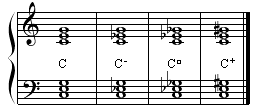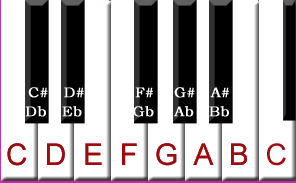Basic Chords the Musicians Words
 Let’s explore the element of music theory chords.
Let’s explore the element of music theory chords.
Music chords are the structures that are the words of music and are constructed with the notes of the scale and in all the key signatures.
A lot of things to consider?
It is, however, by taking a step through the process of how various chords are built you will have the fundamental knowledge necessary to work with any key signature and any scale you want to use.
Types of Chords
There are several types of chords just as with scales they are listed here with basic definitions.
- Major Chord
-
Minor Chord
-
Diminished Chord
-
Augmented Chord
- Seventh Chords
-
Extended Chords and others
Constructing a Music Chord
You can use the 12 notes with there corresponding sharps and flats to build a chord.
This will cause you to also move into a second octave of notes as you reach the set of notes for any one octave.
It is best to start small and build with 3 notes at a time.
Use the keyboard section below and we will build the different types associated with the key of C.
The music theory chords are developed mathematically using a set number of whole and half steps and minor third steps (intervals).

If we assign a numeric value to each note each scale will use the numbers 1 2 3 4 5 6 7 8 and you will have one of each in the scale.
These are the intervals.
1 2 3 4 5 6 7 8
C D E F G A B C
Steps and Intervals Demonstrated
W=whole step – C to D
H=Half Step – C to C#
m3=minor 3rd which is a whole and a half step together. C to Eb
3rd=major 3rd which is two whole steps (4 half steps) – C to E
We will use the S= Start position then add the steps to construct a scale.
Each of the following ways to make chords is shown with the chord name, the intervals, the half steps and the chord notes.
Major Chord:
 Mathematically the major chord is produced using the following formula.
Mathematically the major chord is produced using the following formula.
4 H + 3 H.
C Major – C
1 3 5 S + 4H + 3H C E G
Minor Chord:

Mathematically the minor chord is produced using the following formula. (flat the 3rd)
1 b3 5 S +3H + 4H C Eb G
Diminished Chord:

Mathematically the diminished chord is produced using the following formula. (flat the 3rd and the 5th) the degree symbol is used to designate the diminished chord.
C diminished – Cº
1 b3 b5 S +3H +3H C Eb Gb
Augmented Chord:

Mathematically the augmented chord is produced using the following formula. (raise the 5th ) the plus symbol is used to designate the augmented chord
C Augmented- Cº
1 3 #5 S +4H +4H C E G#
Seventh Chords:

Mathematically the seventh chords add a fourth note and are used to create some tension that resolves to a root chord such as a major chord. The most common is the dominant seventh Which is a major chord with an added b7.
1 3 5 b7 S +4H +3H +3H C E G# Bb

The Major Seventh chord uses 4 half steps to add the seventh.
1 3 5 7
S + 4H + 3H+ 4H
C E G B
For more on sevenths learn more at the seventh chords.
Extended Chords:

Mathematically you can add any note of the scale and extend your chords. This takes some explaining but it is as simple as adding 3 or 4 half steps (major or minor 3rds). The example we will use to illustrate that is a C11 which uses the 1, 3, 5, b7, 9, 11; the 9 would likely be dropped to play the 11th, but not necessarily.
1 3 5 b7 9 11
S + 4H + 3H + 3H + 4H + 3H
C E G Bb D F

So there is just a quick introduction to basics of music theory chords.
Learning Resources

